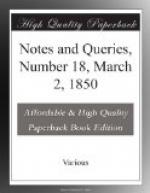“Ego has tubulas Prutenicas
dici volui, ut sciret posteritas
tua liberalitate, Princeps
Alberte, nos adjutos esse, et tibi
gratiam ab iis, quibus profuturae
sunt deberi.”
Reinhold therefore called them Prutenie, i.e. Prussian tables, in compliment to the reigning duke. Pruteni is an ancient name of the Prussians. Albert (grandson of Albert the Achilles, Margrave of Brandenburg) was in 1511 elected Grand Master of the Teutonic Knights, who then held Prussia. He continued the war which his order had for some time carried on with his uncle, Sigismund I., King of Poland. But he subsequently embraced the doctrines of Luther, deserted his order, became reconciled to Sigismund, and for his reward East Prussia was now first raised into a duchy as a fief of Poland, and made hereditary in his family. This Albert was the founder of the University of Konigsberg. (See Puffendorff, Frederick the Great, and Robertson.)
Pandoxare (No. 13. p. 202., No. 15. p. 234.).—There is, or till very lately was, an officer of Trinity College, Cambridge, called the Pandoxator. He had the oversight of the college brewhouse, and formerly of the college bakehouse also. See Monk’s Life of Bentley, 2nd ed. i. 210. In Dr. Bentley’s time the office seems to have been held by a senior fellow. Of late years junior fellows have held the situation.
C.H. Cooper.
Cambridge, Feb. 11. 1850.
Gazetteer of Portugal.—In answer to the inquiry of “Northman” (No. 16. p. 246.), P.C.S.S. has to state, that he believes that the most recent, as it is unquestionably the most copious, work on the topography of Portugal is the Diccionario Geografico de Portugal, published at Lisbon in 1817, in seventeen volumes, 8vo.
P.C.S.S.
Dog Latin (No. 15, p. 230.).—Many things low and vulgar are marked with the prefix “dog”; as dog-rose, dog-trick, dog-hole, as also dog-gerel. When the great mortar was set up in St. James’s Park, some one asked “Why the carriage was ornamented with dog’s heads?” “To justify the Latin inscription,” said Jekyl.
C.
Epigram (No. 15. p. 233.).—Surely not by Kenrick, if written, as it seems, about 1721. Kenrick was not heard of for near thirty years later.
C.
Pallace, Meaning of (No. 15. p. 233.).—Put out of all doubt by the following article in Phillips’s World of Words. “Pallacia, in old records, ‘Pales or paled fences.’”
C.
Meaning of Pallace (No. 13. p. 202., and No. 15. p. 233.).—Bishop Horsley seems to throw some light on this point by his note on the 9th verse of the 45th Psalm. The learned prelate says




